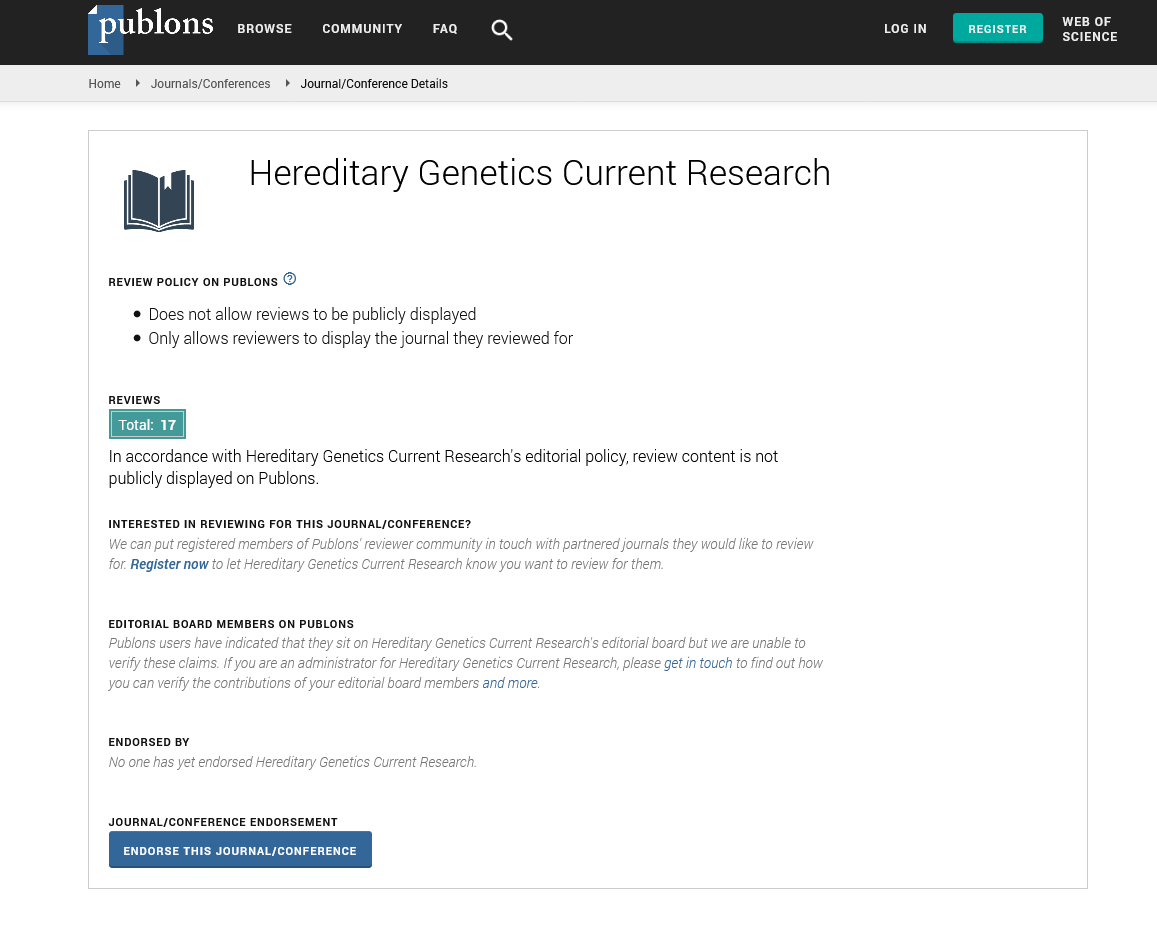Indexed In
- Open J Gate
- Genamics JournalSeek
- CiteFactor
- RefSeek
- Hamdard University
- EBSCO A-Z
- NSD - Norwegian Centre for Research Data
- OCLC- WorldCat
- Publons
- Geneva Foundation for Medical Education and Research
- Euro Pub
- Google Scholar
Useful Links
Share This Page
Journal Flyer

Open Access Journals
- Agri and Aquaculture
- Biochemistry
- Bioinformatics & Systems Biology
- Business & Management
- Chemistry
- Clinical Sciences
- Engineering
- Food & Nutrition
- General Science
- Genetics & Molecular Biology
- Immunology & Microbiology
- Medical Sciences
- Neuroscience & Psychology
- Nursing & Health Care
- Pharmaceutical Sciences
Opinion Article - (2023) Volume 12, Issue 3
Molecular Analysis of Urologic Tumours for Accurate Cancer Detection, Staging, Treatment Planning and Monitoring
Julien Boiteau*Received: 01-Sep-2023, Manuscript No. HGCR-23-23018; Editor assigned: 04-Sep-2023, Pre QC No. HGCR-23-23018 (PQ); Reviewed: 18-Sep-2023, QC No. HGCR-23-23018; Revised: 25-Sep-2023, Manuscript No. HGCR-23-23018 (R); Published: 02-Oct-2023, DOI: 10.35248/2161-1041.23.12.255
Description
Urologic oncology refers to the field of medicine that focuses on the diagnosis and treatment of cancers affecting the urinary tract and male reproductive organs. These cancers include bladder cancer, kidney cancer, prostate cancer and testicular cancer, among others. The successful management of urologic malignancies depend on accurate diagnosis and staging to guide treatment decisions. In recent years, targeted molecular imaging has emerged as a potential approach to enhance the accuracy of cancer detection, characterization and treatment monitoring. Targeted molecular imaging involves the use of specific ligands, often labeled with imaging agents, to bind to molecular targets that are overexpressed or unique to cancer cells. These ligands can be monoclonal antibodies, peptides, small molecules, or nanoparticles, designed to interact with biomarkers associated with cancer progression. By utilizing various imaging modalities such as Positron Emission Tomography (PET), Single-Photon Emission Computed Tomography (SPECT), Magnetic Resonance Imaging (MRI) and optical imaging, targeted molecular imaging enables the visualization and quantification of molecular processes in vivo.
Biomarkers are measurable indicators that provide information about biological processes, disease presence and response to therapy. In urologic oncology, biomarkers play a vital role in risk assessment, early detection, treatment stratification and therapeutic monitoring. However, traditional biomarkers often lack specificity and sensitivity. Targeted molecular imaging offers a transformative approach by allowing the visualization of biomarkers at the molecular level, facilitating early and accurate cancer detection, staging and treatment response assessment. Prostate-Specific Membrane Antigen (PSMA) is a potential biomarker in prostate cancer. PSMA-targeted PET imaging with radiotracers like 68Ga-PSMA-11 enables the precise localization of prostate cancer lesions, even at low Prostate-Specific Antigen (PSA) levels. This aids in identifying metastases and guiding targeted therapies. Fibroblast Activation Protein (FAP) is associated with tumor growth in bladder cancer. FAP-targeted imaging agents have shown potential for detecting early-stage bladder cancer and monitoring treatment response, enhancing the accuracy of transurethral resection and guiding adjuvant therapy decisions. Clear Cell Renal Cell Carcinoma (ccRCC) is the most common type of kidney cancer. Carbonic Anhydrase IX (CA-IX) is frequently overexpressed in ccRCC. Molecular imaging targeting CA-IX can aid in the differentiation of ccRCC from benign lesions and assist in planning partial nephrectomies.
Targeted molecular imaging offers higher sensitivity and specificity compared to conventional imaging modalities, reducing false-positive and false-negative results. By identifying molecular changes associated with early carcinogenesis, targeted molecular imaging can enable the detection of tumors at an earlier stage, improving patient outcomes. Molecular imaging provides insights into individual patients' biomarker expression profiles, facilitating personalized treatment strategies and optimizing therapeutic responses.
Monitoring biomarker expression changes during treatment allows for real-time assessment of treatment efficacy, enabling timely modifications in therapeutic regimens. The development of effective imaging agents involves optimizing ligand design, radiolabeling strategies and stability to ensure accurate and reproducible results.
Regulatory approval processes for new imaging agents are complex, requiring rigorous validation, safety assessments and clinical trials. The lack of standardized protocols for imaging acquisition, interpretation and reporting can inhibit the widespread adoption of targeted molecular imaging. Targeted molecular imaging techniques can be expensive and may not be widely accessible, limiting their integration into routine clinical practice. Future directions include refining radiotracer design, advancing imaging modalities, establishing standardized protocols and conducting large-scale clinical trials to validate the clinical utility of targeted molecular imaging in urologic oncology.
Conclusion
Targeted molecular imaging has the potential to revolutionize urologic oncology by functioning as a biomarker for accurate cancer detection, staging, treatment planning and monitoring. By visualizing molecular processes, this approach enhances the sensitivity and specificity of cancer imaging for early detection and customized treatment strategies.
Citation: Boiteau J (2023) Molecular Analysis of Urologic Tumours for Accurate Cancer Detection, Staging, Treatment Planning and Monitoring. Hereditary Genet. 12:255.
Copyright: © 2023 Boiteau J. This is an open-access article distributed under the terms of the Creative Commons Attribution License, which permits unrestricted use, distribution and reproduction in any medium, provided the original author and source are credited.

